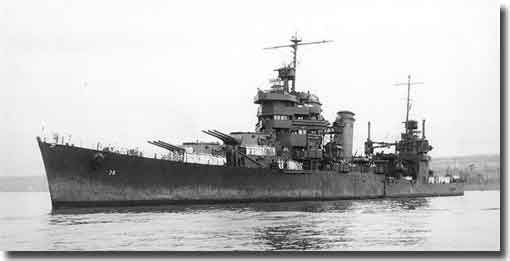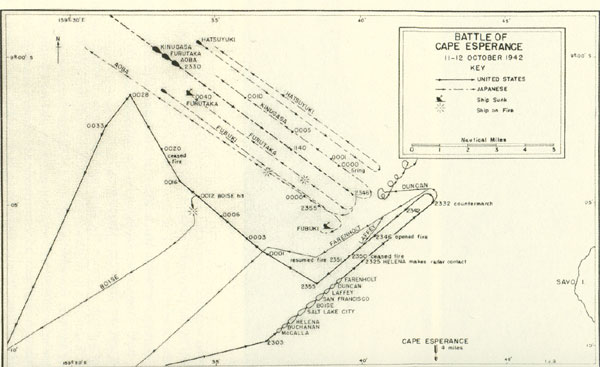|
Introduction.
US naval forces in the South Pacific were at this time, still suffering from the operation of Japanese submarines infesting Torpedo Junction ( that part of the Pacific between the Solomons and Espirito Santo )
The Tokyo Express made its nightly run to try and reinforce their troops ashore on Guadalcanal.
The US Marines ashore were hard pressed, and at sea, were down to but one operational carrier, the USN had its work cut out to cope with covering Turner whenever he tried to reinforce those fighting to survive on the "canal."
The trials of October 1942.
Turner in his flagship McCawley, with the transport Zeilin, and 8 destroyers, sailed out of Noumea on the 9th. of October aiming to anchor off Lunga Point on the 13th.
Rear Admiral Murray with his Hornet TF were 180 miles SW of Henderson Field, Rear Admiral Lee with the Washington group stayed 50 miles east of Malaita, whilst Rear Admiral Scott in San Francisco, with his TF 64, comprising Salt Lake City, two light cruisers, Boise and Helena, screened by the 5 destroyers: Farenbolt, Buchanan. Laffey, Duncan and McCalla were off Rennell Island, it was the 11th. of October.
Scott planned to form his force to cruise in column, 3 destroyers leading the cruisers with 2 destroyers astern. He now received a signal indicating 2 Japanese cruisers with 6 destroyers were coming down " The Slot.", they were reported 210 miles away, to bring them to action he needed to be off Savo by 2300 ( 11PM )
Another signal said that Henderson Field had been attacked by 75 planes in four waves.
Japanese Forces.
At 2200 ( 10 PM ) Rear Admiral Goto in the heavy cruiser Aoba, was followed by 2 heavy cruisers Kinugasa and Furutaka, then the destroyers Hatsuyuki and Fubuki on the port and starboard beams.
His job to cover a reinforcement group of the two seaplane tenders Nisshin and Chitose, surrounded by 6 destroyers, on board much of the 2nd. Division. A report of flickering lights ahead were thought to be the landing group, but no response was received when Aoba signalled them.
Scott and his force were within 13 miles of Cape Esperence.
At 2208 ( 10.08 PM ) Helena’s radar picked up a contact at almost 14 miles distance, but for some unknown reason it them almost 15 minutes to confirm and inform Scott, then, Salt Lake City reported 3 ships at 8 miles.
Now a scout aircraft reported “many enemy ships” approaching Cape Esperance.
Scott ordered a 180 degree turn to reverse the course of his group, before the destroyers previously leading the column could regain their position in the van, Duncan picked up a contact 4 miles to starboard, Laffey had not yet altered course, and Duncan’s Captain assumed she too had this contact and would join him. He charged off at 30 knots to engage the enemy, but all by himself.
At 2242 ( 10.42 PM ) Boise and Helena reported a contact by radio telephone ( TBS ) Helena asked permission to open fire, to receive a “Roger” was this a “Roger” to open fire, or merely a “Roger” acknowledging receipt of the message?
All very confusing verbal communications!
On Helena’s bridge, this “Roger” was taken to be “ Get on with engaging the enemy”
On went her searchlight and the guns opened fire, Rear Admiral Scott on the bridge of his flagship was suprised when gunfire broke the evening calm.
Now Salt Lake City, and the rest of the column, including the flagship San Francisco all opened fire.
Aoba was hit, and Goto ordered a starboard turn, Aoba and Furutaka both altered course to starboard, but Kinugasa and the destroyer Hatsuyki turned to port, poor communications in the heat of battle, also in the Japanese ships.
Another shell struck Aoba’s bridge and Vice Admiral Goto mortally wounded, Furutaka was also in trouble being hit, as was Murakumo, it was the turn of the IJN to be on the wrong end of the gunfire tonight.
But back to the US destroyer Duncan, she was now very much alone, hit in the boiler room, her Commanding Officer Lieutenant Commander Taylor ordered his company to “abandon ship.”
Farenbolt was hit, maybe by incoming friendly shell fire, she kept afloat, and staggered off toward Tulagi.
Furutaka was ablaze, hit in No 3 turret, in No 2 torpedo tube, and also in both engine rooms, she was in her death throes, and was soon abandoned.
San Francisco using her search lights illuminated the Japanese destroyer Fubuki, caught like a rabbit in the headlights of a car at night , she was soon eliminated.
Rear Admiral Scott's flagship USS San Francisco at Pearl Harbor December 1942, for repairs after battle damage at Guadalcanal.
 |
Boise took hits from Aoba and Kinugasa, Furutaka, 20 miles NW of Savo, rolled over and sank at 0208. ( 2.08 AM )
It was all over, the Battle of Cape Esperence finished.
Conclusion.
Both sides thought of it as a victory, Scott had turned back the Japanese force who lost a heavy cruiser and a destroyer, and the Aoba damaged with her Admiral killed.
The Japanese had sunk the destroyer Duncan, severely damaged the cruiser Boise, and damaged the destroyer Farenbolt.
Scott with a superior force and the element of suprise should, I believe, have achieved heavier casualties upon the Japanese force.
Communications procedures needed to be tightened up, and he was probably lucky to have got away with only Boise badly damaged, Farenbolt damaged, and Duncan sunk.
It also appeared that Rear Admiral Scott did not fully appreciate the value of the SG or surface radar, over the SC or long distance air search radar he had in his flagship ( San Francisco was not fitted with a SG set, and he had to rely on his other ships to keep him informed, losing valuable time, the suprise element, and tactical control ) But, at this early stage of the USN at war, not many Senior Naval Officers had embraced this new " Black Art."
On the Japanese side of the fence, Admiral Tanaka thought the Battle of Cape Esperence a crushing defeat for the IJN.
Battle of Cape Esperance, click on the picture to see a bigger image.
 |
|